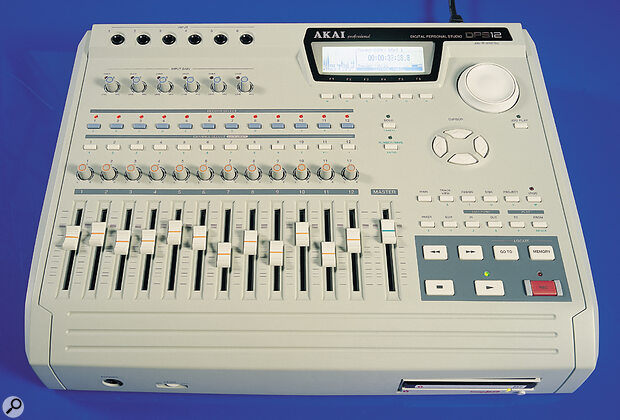 Akai's DPS12: like any digital recorder, it can benefit from a number of techniques to add 'analogue warmth'.
Akai's DPS12: like any digital recorder, it can benefit from a number of techniques to add 'analogue warmth'.
I have a reasonably modest home recording studio incorporating an Akai DPS12 hard‑disk multitracker with onboard effects, a Rode NT1 mic, a Joemeek VC3 voice channel, an Ensoniq 16 Plus sampler and a couple of guitars and amps. I was wondering whether there is a piece of kit that would add some 'tape‑like analogue warmth' to the digital domain I'm recording in, preferably at an affordable price?
Barry Meston
Assistant Editor Mike Senior replies:
The bad news is that if you want to stay in the digital domain it's likely to prove very pricey. For example, SPL's Machinehead tape‑saturation emulator is in the £2000 range, and though there are also some computer plug‑ins which perform similar functions, that's no use to you in your setup.
The good news, however, is that there are several easy and cheap ways to achieve 'analogue warmth' in the analogue domain (surprise!):
• The simplest way to give any instrument 'analogue warmth' is record it at a high‑ish level on to ordinary cassette tape, then re‑record it from there onto your DPS12. This should work well for things like drums, where the compression can sound really nice and help them sit better in the mix. If you want to give an entire mix that quality, the best thing would be to go for a second‑hand quarter‑inch stereo tape recorder. A good one should provide good enough audio quality that you can achieve an analogue sound, by bouncing the entire track onto and off it, without incurring too much noise. It's worth remembering, however, that in order to get good results from tape, the machine needs to be well lined up and maintained.
- For drums, which is the area on which a lot of the debate about analogue warmth is focused, you could try re‑recording them through your guitar amp and then mixing this with the original sound. A large part of the effect of tape saturation on drums is limiting the transients at the start of each hit: you may be able to achieve a similar effect either by deliberately overloading the inputs of your multitracker, or recording the drums at too high a level so that they are deliberately 'clipped'. One of the major differences between analogue and digital recorders is that while overloading the former produces a musical form of distortion, digital distortion usually renders a track unusable. However, very brief digital clipping at the start of a drum hit is often inaudible, and can help to reduce the dynamic range of digitally recorded drums in a similar way to saturated analogue tape. Another variation on this idea is to take a few dBs off the signal with the fastest limiter you can get your hands on, set to its fastest attack and release times.
To help drums sit in a mix once they're in the DPS12, I often find that sending a feed from them to a short, dense reverb, which itself is then sent through a compression and distortion algorithm, is a good idea; subtly mixing in a pumping, distorted reverb can really pad out thin‑sounding drums without being too obvious.
- You could consider getting hold of some valve equipment. All manner of budget‑conscious valve preamps, mics, and channel strips are available now, and if you get a stereo valve EQ you could find that strapping this across the output of the Akai might do the trick. Similarly, most digital mastering processors (such as the TC Finalizer, Dbx Quantum, and Drawmer DC2476) include some form of 'valve‑like' enhancement to add the sheen you're after.
- It may be worth trying out some of the aural enhancers available, as well, although they tend to be best at adding clarity rather than warmth — each model has its own character. The SPL Transient Designer may also be worth a look: it's an unusual processor, which some people claim is able to emulate tape saturation.
